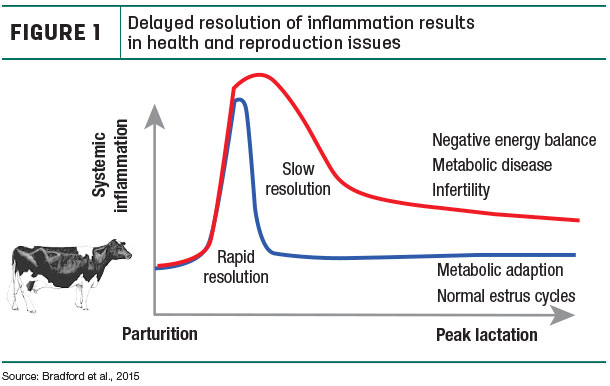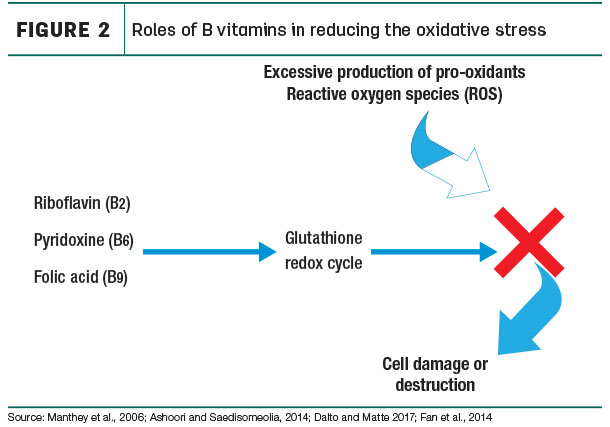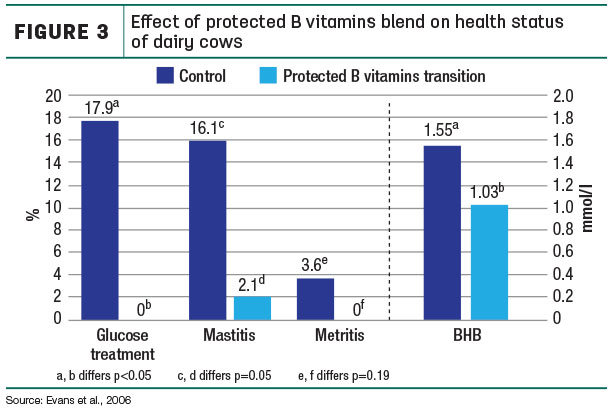The immune response is part of this adaptation. Five critical points during the transition period impact its effectiveness:
- Reduced capacity of the immune system to respond
- Excessive mobilization of adipose tissues to meet energy requirement
- Low blood calcium (hypocalcemia) caused by the sudden increase in calcium demand for milk production
- Dysfunctional inflammation response which may lead to chronic inflammation when resolution of inflammation is delayed (Figure 1)

- Oxidative stress caused by the imbalance between the excessive production of pro-oxidants and the insufficient quantity of antioxidants
The immune system has two components, the innate and the adaptive. The innate system is non-specific and will respond within a few hours. It consists mainly in the action of immune cells like the neutrophils to destroy the invader agent and in the action of the cytokines, which will trigger an inflammation response. The adaptive system will be activated only when the innate system had not succeeded, and it may take a few days to be effective through mainly the production of specific antibodies. Most of the immune response during the transition period will be through the innate system.
Just having the innate immune cells is not enough. The immune cells (neutrophils) need calcium and glucose to support their functions. After calving, when the cow’s blood calcium level is reduced and glucose supply is limited, the neutrophils’ function will be reduced.
Since dairy cows need to mobilize body fat tissues to meet the increased energy requirement for milk production, the blood non-esterified fatty acids (NEFA) level increases and, in cases when liver function is suboptimal, glucose synthesis will be reduced and the blood beta-hydroxy-butyrate (BHB) level will be increased.
Excessive blood NEFA during the transition period will negatively impact the production and function of neutrophils. During that period, the fatty acid profile of the blood NEFA will be modified towards more saturated fatty acids, which will be reflected in the fat composition of the immune cell, creating a pro-inflammatory response.
Excessive blood BHB levels (ketotic cows) have been shown to lower the function of the neutrophils by reducing their ability to migrate to the infected sites, and this was related to increased mastitis and metritis incidence during the first weeks after calving.
In addition to these events, oxidative stress increases during the transition period due to the elevated production of reactive oxygen species (ROS), which are pro-oxidants. These are byproducts of normal cell function but, when their production is excessive due to inflammation, elevated blood NEFA and increased cell metabolism, the antioxidant capacity of the cow is not sufficient to counteract it. This will lead to cell damage or destruction in the liver or other organs.
Dysfunctional inflammation, oxidative stress and excessive body fat mobilization are linked and altogether will trigger metabolic stress to the cow during the transition period. This will increase the risk of metabolic and infectious diseases during the transition period and will impact future milk production and reproduction.
Some nutritional solutions are available to support the dairy cow during this challenging time, and the dietary supplementation of a specific protected B vitamins blend has been proven to improve dairy cow health.
Some B vitamins play specific roles in the immune response either directly or indirectly. Three B vitamins (B6, B2 and B9) are involved in the reduction of oxidative stress by their action in the glutathione redox cycle, which will inactivate the ROS action on cell damage or destruction (Figure 2).

Moreover, the injection of riboflavin (B2) was shown to increase neutrophil production and function in dairy cows.
A blend of protected B vitamins (choline, riboflavin [B2], folic acid [B9] and B12) fed in the diet of transition cows was shown to increase dry matter intake (DMI) before and after calving, to reduce blood BHB levels and to reduce liver fat content. All of those effects will have an indirect positive impact on the immune response of the dairy cow and may explain why cows had less mastitis, metritis and ketosis in various studies using the same blend of protected B vitamins (Figure 3).

The immune response during the transition period is dysfunctional and is impacted by various physiological, nutritional and management factors. Supporting the immune response either directly or indirectly with the dietary supplementation of a blend of protected B vitamins is an innovative and natural strategy to keep cows healthier after calving. ![]()
References omitted but are available upon request. Click here to email an editor.

-
Hélène Leclerc
- Technical Support and R&D – Ruminant Nutrition
- Jefo
- Email Hélène Leclerc






